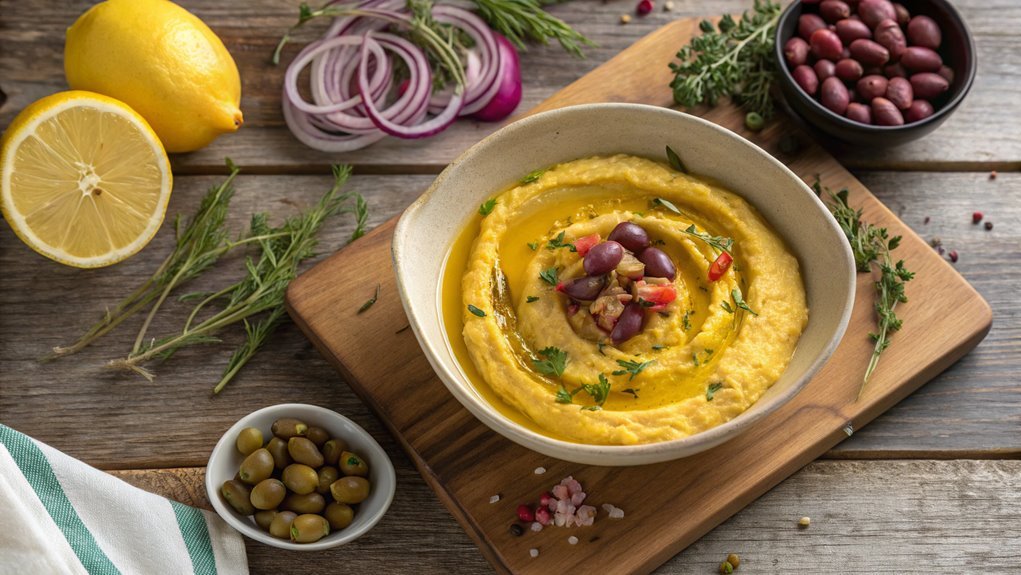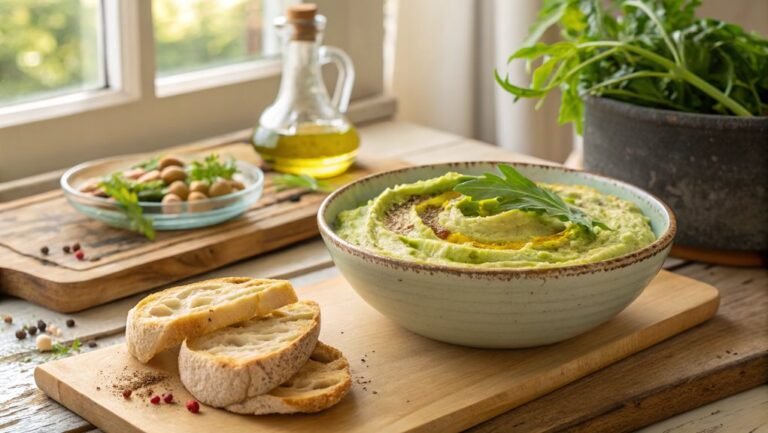Authentic Santorini Fava Recipe

Imagine savoring the sunlit flavors of Santorini with each bite of creamy fava. Made from yellow split peas, this dish is a simple yet satisfying culinary treasure. With just a few fresh ingredients, create a delightful appetizer or side dish perfect for sharing. Ready to embark on this flavorful journey? Let’s dive into a recipe that transports you straight to Greece!
Recipe
Indulge in the delightful flavors of the Mediterranean with authentic Santorini Fava! This comforting dish, known for its creamy texture and bright taste, is a staple in Greek cuisine. By using high-quality yellow split peas, ideally sourced from Santorini, you can recreate this classic dish at home with ease. The gentle sweetness of sautéed onions combined with the smoothness of blended peas makes for an unforgettable culinary experience.
As you prepare to make Santorini Fava, remember that simplicity is key. With just a few ingredients and straightforward cooking techniques, you can achieve a rewarding dish that brings the taste of Greece right to your table. The final garnish of capers and lemon zest adds a burst of freshness that perfectly complements the rich flavors of the fava. Additionally, Santorini fava is known for its velvety texture which enhances the overall dining experience.
Ingredients:
- Yellow split peas
- Onions
- Extra virgin olive oil
- Water
- Capers
- Lemon zest
- Salt
- Pepper
Cooking Instructions:
- Preparation:
- Rinse the yellow split peas thoroughly under cold water to remove any impurities.
- Peel and finely chop the onions.
- Sautéing:
- In a large pot, heat a generous amount of extra virgin olive oil over medium heat.
- Add the chopped onions and sauté until they become sweet and soft, about 5-7 minutes.
- Cooking the Peas:
- Add the rinsed yellow split peas to the pot with the sautéed onions.
- Pour in enough water to cover the peas completely.
- Bring the mixture to a boil, then reduce the heat to low and let it simmer for 40-50 minutes.
- Skim off any foam that forms on the surface during cooking.
- Blending and Seasoning:
- Once the peas are tender, remove the pot from the heat.
- Using an immersion blender, blend the mixture until smooth and creamy.
- Taste and adjust the seasoning with salt and pepper to your preference.
- Serving:
- Transfer the fava to a serving dish.
- Garnish with capers and lemon zest for an added zing.
- Serve warm with fresh, crusty bread.
Extra Tips:
For the best texture, ensure that the yellow split peas are cooked until they’re completely tender before blending. If the fava becomes too thick after blending, you can add a little warm water to reach your desired consistency.
Additionally, using high-quality extra virgin olive oil will enhance the overall flavor of the dish. Remember, patience is key; allowing the peas to simmer slowly ensures a creamy and smooth result. Enjoy your homemade Santorini Fava as a delicious appetizer or a savory side dish!
Frequently Asked Questions
What Is the Origin of Santorini Fava?
Santorini fava has roots in ancient Santorini agriculture, dating back over 3,500 years.
It thrives in the island’s unique volcanic soil, which, combined with its distinctive microclimate, gives the fava beans a delightful flavor.
Cultivating fava involves careful practices like sowing in December and harvesting in June.
These beans, rich in nutrients, have become a cherished staple, presenting a wonderful opportunity for you to explore and enjoy traditional dishes that celebrate this culinary heritage!
Can I Substitute Santorini Fava With Other Legumes?
Absolutely, you can substitute Santorini fava with several legume alternatives!
Edamame and lima beans offer similar textures and nutritional comparisons—think fiber and protein!
If you’re looking for something quicker, green peas cook faster, while chickpeas provide hearty flavor.
Remember, while these substitutes create delightful dishes, they won’t replicate the exact taste.
Experimenting with these options can lead to exciting meals.
Get cooking, and enjoy discovering your new favorite legume dish!
How Should I Store Leftover Santorini Fava?
To store your leftover fava, keep it in an airtight container in the refrigerator.
It’ll stay fresh for up to five days!
For longer storage, portion it into freezer-safe containers; frozen fava lasts up to three months.
When you’re ready to enjoy it again, thaw in the fridge, then reheat gently on the stove or in the microwave.
Don’t forget to add your favorite spices to enhance those delicious flavors!
Is Santorini Fava Gluten-Free?
Imagine diving into a bowl of sunshine—that’s what Santorini fava is like! Yes, it’s gluten-free, offering incredible benefits for your body.
Made from yellow split peas, it’s nutritious, packed with plant-based protein and fiber, making it a wonderful choice for everyone.
Being naturally dairy-free and vegan, you can enjoy its rich flavors during any meal.
Give it a try, and you’ll discover a delicious, wholesome dish that nourishes both body and soul!
What Dishes Pair Well With Santorini Fava?
When you’re exploring what dishes pair well with Santorini fava, think of vibrant Mediterranean flavors.
Traditional pairings include grilled meats, seafood, and colorful veggie crudites, all complementing that creamy texture.
Enjoy it alongside a meze platter featuring tzatziki and melitzanosalata, or with hearty lamb meatballs.
Don’t forget to savor it with a glass of Assyrtiko wine, and let those flavors transport you to sunny Santorini.
You’ll love every bite!
Conclusion
Having crafted this delightful Santorini fava, get ready to impress your friends and family! The creamy texture and vibrant flavors are simply irresistible. Pair it with crusty bread for the perfect bite. As an appetizer or a side, this dish transports you to the sunny shores of Greece. Savor the magic and enjoy every delicious moment!




